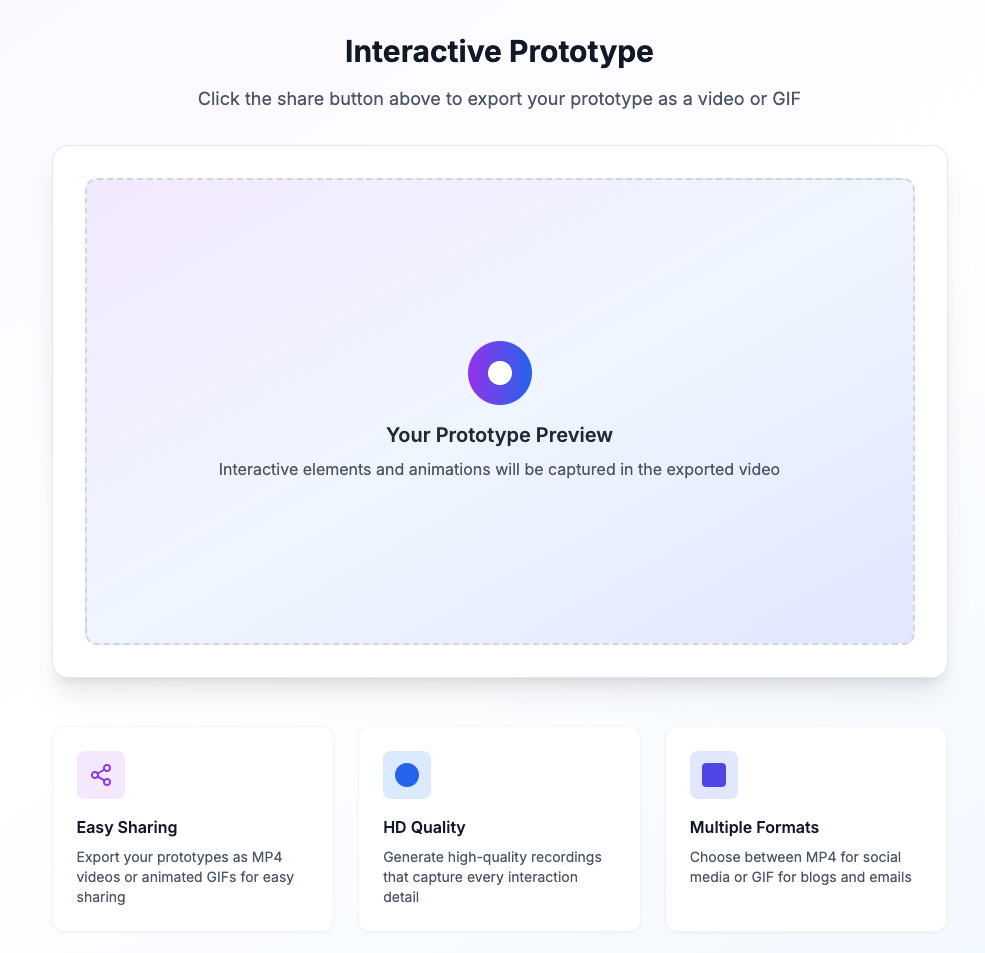From Idea to Interactive Prototype in Minutes: My Lovable Workflow ⚡
Show, don't tell: How working prototypes transformed my product conversations
I've been interviewing with a few companies recently, and I have a secret weapon that's been making my competition sweat. 😅
It's a process that lets me go from a rough strategic idea to a fully interactive, high-fidelity prototype in under an hour. Not a PowerPoint mockup. Not a Figma wireframe. A prototype I can actually click through, share a link to, and demo live in interviews. 🚀
A prototype that makes my ideas tangible and shows—rather than tells—how I think as a product leader.
The core of this process is a tool I've been using obsessively: Lovable. 💜
This article breaks down my exact workflow for turning strategy into working software in minutes. But here's the twist: I'm going to show you by building something for Lovable itself. Using Lovable. Meta? Absolutely. Effective? You'll see.
Here's how excited I would look as a Pixar character making interactive prototypes. Thank you Gamma for auto generating this picture while making me an amazing presentation of this. You can check out the Gamma summary of this article here.
First, What is Lovable? 🤖
Think of Lovable as an AI-native product studio that turns your product requirements into interactive, full-stack web applications. You describe what you want to build, and Lovable generates not just a visual mockup, but a working prototype with real functionality. ✨
It's competing in a space with tools like Cursor and Bolt, but I've found Lovable to be far more accessible for non-engineers. My personal laptop is getting a bit old and can't handle heavy development environments, so a web-based tool that does the heavy lifting is a lifesaver. 💻
It's like having a scrappy junior engineer on call, one who never complains about scope creep and works at 3x speed. 🏃♂️💨
My 4-Step Flywheel for Insanely Fast Prototyping 🔄
This is the exact workflow I've used to create impressive prototypes for interview take-homes. It's a systematic approach that compounds: each step feeds into the next, creating a flywheel from high-level strategy to detailed execution. 🌪️
Step 1: AI-Powered Growth Strategy 📈
I start with my custom GPTs. Since my expertise is in consumer growth, I have a Growth Strategy GPT trained to generate comprehensive growth strategies for any company. I feed it the company I'm analyzing, and it gives me a strategic foundation with specific lever identification. 🎯
Step 2: Generate the Product Roadmap 🗺️
I copy the strategy output and use it to guide my Product Roadmap GPT. I critique and refine the output until I have a clear roadmap with three big product bets, enough to show strategic thinking without overwhelming the prototype. 🎲
Step 3: Create the Product Requirements Document (PRD) 📋
Here's a hack I learned from
’s How I AI podcast: treat AI like a junior engineer who needs extremely detailed instructions. I ask ChatGPT or Claude to create a comprehensive PRD for each product bet, specifically written for someone building their first prototype. 🤖The key is being explicit about user flows, edge cases, and visual hierarchy. Vague requirements get you vague prototypes. 📝
Step 4: Let Lovable Work Its Magic ✨
If my AI-generated PRD is too long for Lovable's input window, I have another trick. I tell ChatGPT: "I'm going to copy and paste this into Lovable. Adapt it so it fits perfectly in their context window without me having to do any editing." The AI refines the prompt, often adding helpful implementation details. 🔧
Then I paste that optimized PRD into Lovable and watch the prototype materialize. Sometimes it takes a few iterations, but the back-and-forth is intuitive and fast. ⚡
Putting It to the Test: Building Lovable's Next Feature, With Lovable 🛠️
To demonstrate this workflow's power, I turned my process on Lovable itself. I used my GPTs to generate a strategy and roadmap for them. I even asked my strategy GPT to channel Mike Krieger, Instagram's co-founder, because Instagram represents product excellence. My GPT helpfully invented an awesome "Mike Krieger Principle" that doesn't actually exist but should. 📸
If users feel blocked, you failed. If they feel expressive, you win.
Here's the strategic vision that emerged:
The Big Vision: Build software at the speed of thought. Shape it like clay. Share it like a story. Lovable should become the Figma of full-stack AI development—faster, more intuitive, and infinitely more shareable. 🎨
The 3 Strategic Bets: 🎯
I then took two of these bets, Interactive Canvas (link) and Viral Creator Mode (link), and used Lovable to build a working prototype of what that feature could look like. 🎬
Prototype 1: Interactive Canvas
The prototype lets users click on the various elements of the page and edit them. Each section is treated like a building block you can surgically edit with guided quick actions.
Prototype 2: Viral Creator Mode
The prototype aims to let users (if I hadn’t run out of Lovable credits):
Generate shareable video previews of their prototypes 📱
Add custom branding and themes 🎨
Export demos optimized for LinkedIn, Twitter, and Substack 📢
Track engagement metrics on shared prototypes 📊
My Lovable Wishlist: How a Great Tool Becomes Unstoppable 💜
As a PM, I can't help but product-ize everything I use. While Lovable is already powerful, here are the features that would make it truly category-defining: 🏆
1. Smarter Error Recovery 🔧
Current state: When a prototype fails to generate, Lovable asks me to "retry."
The opportunity: If the AI knows it broke, it should attempt self-correction or provide specific guidance on what input it needs to succeed. No one likes clicking "retry" blindly. 🔄
2. Clay-Like Editing Experience 🏺
The vision: Once the prototype generates, I want to shape it intuitively. Drag-and-drop elements, resize components, comment directly on UI blocks that need changes. This moves beyond chat-based iteration into truly interactive editing. ✨
3. Smart Long-Form Parsing 📖
Current friction: Sometimes my AI-generated PRDs are too detailed and require manual shortening.
The fix: Let me "word vomit" entire documents into the prompt box and have Lovable intelligently parse them into actionable implementation steps. 🧠
4. Viral Shareability Engine 🎬
The game-changer: Export short videos or GIFs of my interactive prototypes for social sharing. Imagine posting a 30-second demo video on LinkedIn that gets 10,000 views and drives 100 new users to Lovable. This creates a massive virality loop. 📈
Hey
! 👋 If you're reading this (and I hope you are!), please consider building this viral shareability feature so I can easily export videos to my Substack and LinkedIn! The growth potential is massive.Check out - she's the Head of Growth at Lovable and absolutely brilliant. 🧠✨5. Context-Aware Commenting 💬
Current confusion: The commenting feature feels ambiguous. Are comments just sticky notes for collaborators, or do they influence the next design iteration?
The clarity: Make it explicit whether comments are for collaboration or for directing AI improvements. 🎯
Offense as a Moat in the Age of AI: Making Your Users Famous 🌟
I want to double-click on viral shareability because it's an underrated growth lever in AI tools. 📢
In 2025, traditional product moats are evaporating. A smart engineer can clone core functionality in a weekend. The defensible advantage isn't your features—it's your brand and your engaged user base. 🛡️
The fastest way to build that? Create a product that helps users generate content that markets your product for them. 🚀
If I was leading growth at Lovable, enabling users to create and share viral-ready prototype demos would be my #1 priority. It's how you build awareness faster than any competitor can replicate. ⚡
Think about it: every shared prototype becomes a mini case study for Lovable's capabilities. Every viral demo drives qualified traffic. Every impressed viewer becomes a potential customer. 🎯
This isn't just a nice-to-have feature—it's a growth multiplier disguised as a product enhancement. 📈
The Future is AI-Native (And It's Already Here) 🤖
Tools like Lovable represent a fundamental shift in how we build products. The old paradigm involved days or weeks of painstaking work to get a decent mockup. The new paradigm is about leveraging AI to get 80% of the way there in minutes, freeing up your cognitive energy for strategy, storytelling, and core insight generation. 🧠⚡
The PMs who dominate the next decade won't be the ones who resist AI tools. They'll be the ones who, like master craftsmen with new power tools, learn to wield them with precision and creativity. 🛠️✨
The question isn't whether AI will change product development. The question is: will you be leading that change, or scrambling to catch up? 🏃♂️💨
Your 15-Minute Challenge ⏰
Want to test this workflow yourself? Here's your homework: 📝
Pick a product you use daily and identify one feature that frustrates you (5 minutes) 😤
Write a simple PRD describing how you'd fix it (5 minutes) 📋
Paste it into Lovable and let the magic happen (3 minutes) ✨
Share the result with someone and ask: "Would this solve the problem?" (2 minutes) 🤔
Seriously, try this. Then reply and tell me how it went. I read every response and often turn the best stories into future articles. 📧
A Heartfelt Thank You 🙏
Before I wrap up, I want to give a massive shoutout to the entire team at Lovable for building this incredible product. I know I'm throwing a lot of feedback your way in this article, but it comes from a place of genuine love for what you've created. 💜
As someone who's definitely more of a "wannabe designer" than the real deal, Lovable has empowered me to bring my product ideas to life in ways I never thought possible. You've turned me into a prototyping machine, and for that, I'm incredibly grateful. 🎨🚀
Keep building awesome stuff! 👏
Found this helpful? Forward it to a PM friend who's still sketching wireframes by hand. They'll thank you. 🎨➡️💻
New here? I write about AI-native product development, career acceleration, and how to 10x your output without losing your mind. Subscribe for free to get tactical frameworks like this every week. 📬✨ https://substack.com/@rodolfodays
Disclaimer 📝
The views and opinions expressed in this article are my own and do not reflect the views of any current or past employer. This content is independent and intended for educational and professional development purposes only.
Keywords 🏷️
AI prototyping, Lovable app, product management, AI tools for PMs, rapid prototyping, product strategy, growth strategy, AI-native development, product requirements, interactive prototypes, Substack, PM productivity








Thank you! 🙏 yeah one challenge I’m noticing with ai tools is that they want to default to using the new chat paradigm as the solution for everything vs leaning on alternative paradigms from other apps to improve user experience. When you say voice and live video, is that for collaboration?
I love this - its awesome to see how youre truly leveraging your domain expertise and figuring out the AI learning curve with experimentation and creating real products! I have so much fun with lovable too and a lot of the thoughts that you shared on how to improve resonates. The clay-like editing experience is something i've thought of too while working on a few different projects on lovable - i wish i could, as you said, drag, drop, resize etc more easily with my control. Otherwise, i also thought that having a voice mode + live video mode/sharescreen feature would be super helpful to make editing communications more seamless. Overall, taking notes on how youre utilizing this stuff for PM work! Great stuff